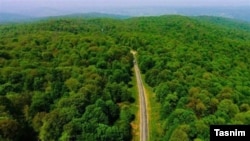An Iranian Forestry Organization official denied on Wednesday that the harvesting and smuggling of soil in Iran's UNESC World Heritage-designated Hyrcanian forests has reached a threatening level.
Abbasali Nobakht, the Forestry Deputy of the Iranian Forestry Organization, admitted he could not deny that there was soil stealing in the Caspian Sea-adjacent forest region, claiming that "some people may move several bags of good quality forest soil and sell it to others,” but maintained that the amount of earth harvested and smuggled was not "as much as it had been reported.”
On Tuesday, the Forestry Deputy of Gilan Province Mohammad Reza Abdollahi was quoted by the Iranian Students News Agency (ISNA) as saying that, in the past, people used forest soil for their private gardens and greenhouses but now "the soil is being systematically harvested and smuggled.”
Dating back to 25 to 50 million years ago, the Hyrcanian forests spread out 850 kilometers along the Caspian Sea’s southern coast, with the forest’s nutrient-rich soils in demand for gardening and greenhouses.
The Hyrcanian forests were registered as the second natural heritage of Iran in the UNESCO World Heritage List in July 2019.
According to UNESCO, the Hyrcanian region features impressively biodiversity, covering just 7% of Iran’s area but containing 44% of the vascular plants known to the country. The forest is home to 180 species of birds and 58 mammal species, including the endangered Persian Leopard.
In July 2019, Masoud Molana, a member of the Coordinating Council for Environment and Natural Resources of Iran, claimed that at least 25,000 hectares (about 61,000 acres) of Hyrcanian forests are lost annually for reasons including deforestation for agriculture, the construction of houses and holiday resorts and illegal tree felling.
According to Molana, half of the Hyrcanian forests have disappeared, leaving only 1,800,000 hectares (4.5 million acres) out of 3,600,000 hectares (8.9 million acres) that existed 40 years ago, and that 90% of the remaining forests have lost their ecological stability.






